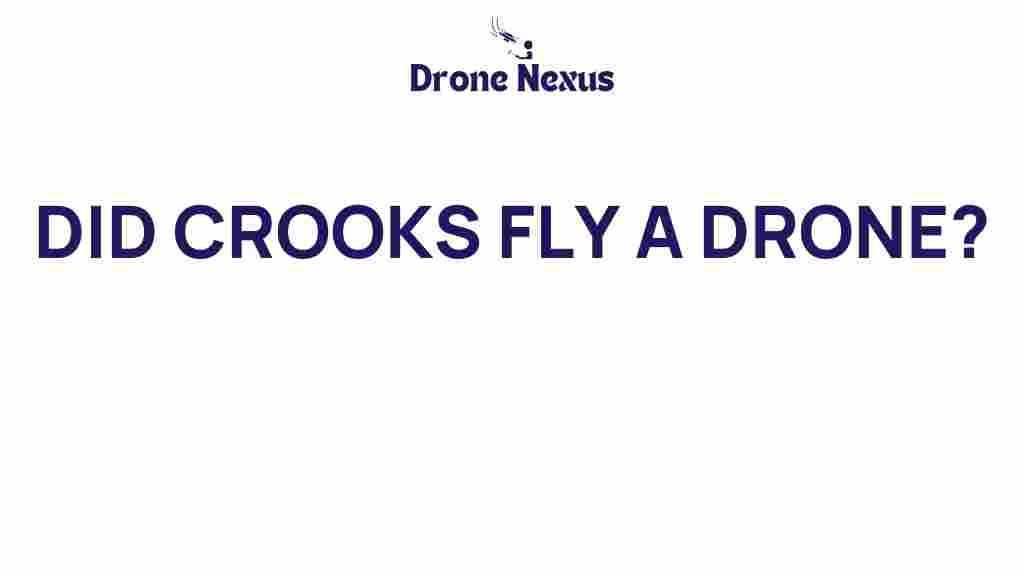Did Crooks Use Drones to Execute Their Cunning Heists?
In recent years, the rise of technology has transformed various facets of our lives, from how we communicate to how we conduct business. One of the most intriguing developments is the use of drones—remotely piloted aircraft that have quickly gained popularity among hobbyists, businesses, and even law enforcement. However, with their growing accessibility, a question arises: have crooks started using drones to execute their cunning heists? This article dives deep into the world of drone-assisted crime, exploring how these devices are being utilized in the underbelly of society.
The Rise of Drones in Criminal Activity
As drones become more affordable and easier to operate, criminals have found innovative ways to leverage this technology for illicit purposes. From surveillance to carrying out heists, drones are revolutionizing the landscape of crime. Here are some common ways crooks are using drones:
- Surveillance: Drones can be equipped with high-resolution cameras, making them ideal for scouting locations before executing a crime.
- Delivery of contraband: Criminals have been known to use drones to deliver drugs and other illegal items, bypassing traditional security measures.
- Breaking and entering: Drones can be used to unlock doors or windows by manipulating security systems from the outside.
Notable Cases of Drone-Assisted Heists
The use of drones in criminal activities is not just theoretical; there are documented cases that highlight this alarming trend:
- Thieves Steal High-End Goods: In 2019, a group of thieves used a drone to survey a luxury store before breaking in. They were able to identify security measures and plan their entry accordingly.
- Drug Trafficking: Law enforcement agencies in various regions have reported instances where drones were deployed to transport drugs across borders, evading traditional checkpoints.
- Prison Breaks: In some instances, drones have been used to deliver tools to inmates to facilitate escape.
How Crooks Utilize Drones in Their Heists
The process of executing a heist using drones can be broken down into several key steps:
Step 1: Reconnaissance
Before any heist, criminals conduct thorough reconnaissance. Drones allow them to:
- Monitor security personnel and their routines.
- Identify potential entry and exit points.
- Gather information on the layout of the target location.
Step 2: Planning the Operation
Once they’ve gathered sufficient data, the planning phase begins. This includes:
- Choosing the right time for the heist based on observed security patterns.
- Deciding which drones to use, considering factors like payload capacity and flight range.
- Mapping out a quick escape route.
Step 3: Execution
During the actual execution, drones can play various roles, including:
- Providing real-time video feeds to monitor the situation.
- Delivering tools or stolen items to accomplices waiting nearby.
- Creating distractions or diversions.
Step 4: Escape
After the heist, drones can assist in the escape by:
- Transporting items to a secure location.
- Providing aerial views to avoid law enforcement.
Common Problems and Troubleshooting Tips for Drone Use in Heists
While using drones may seem straightforward, there are common issues that criminals might face:
Problem 1: Technical Failures
Drones can malfunction or lose connection. To mitigate this:
- Conduct pre-flight checks to ensure all systems are functioning properly.
- Familiarize yourself with the drone’s controls and features.
Problem 2: Law Enforcement Interference
Police and security personnel are increasingly aware of drones being used in criminal activities. To avoid detection:
- Utilize drones with stealth capabilities.
- Monitor police frequencies to stay informed of their movements.
Problem 3: Weather Conditions
Adverse weather can affect drone performance. To prepare:
- Check weather forecasts before planning a heist.
- Have backup plans in case of sudden changes in weather.
Legal and Ethical Implications
The use of drones in criminal activities not only raises legal issues but also ethical concerns. Here are some key points to consider:
- Privacy Violations: Drones equipped with cameras can invade the privacy of unsuspecting individuals, leading to legal repercussions.
- Potential for Harm: If misused, drones can cause physical harm to people and property.
- Legal Consequences: Those caught using drones for illegal activities face severe penalties, including imprisonment.
Conclusion: The Future of Drones and Crime
The intersection of drones and criminal activity reveals a fascinating yet troubling trend. As technology continues to evolve, so too will the methods criminals employ to exploit it. While the majority of drones are used for legitimate purposes, it is essential for law enforcement, policymakers, and the public to remain vigilant about their misuse.
As we look to the future, it’s crucial to establish regulations and laws that can keep pace with technological advancements. For more information on drone regulations, consider visiting this external resource for guidelines and updates.
In the end, the potential for drones to be used in heists raises critical questions about safety, security, and ethics. Raising awareness about these issues can help in developing effective strategies to combat drone-related crime.
If you want to learn more about the impact of emerging technologies on crime, check out our article on the future of crime prevention technology.
This article is in the category Safety and created by DroneNexus Team
